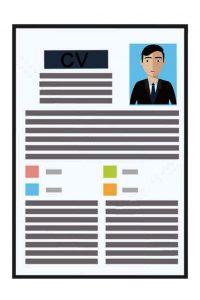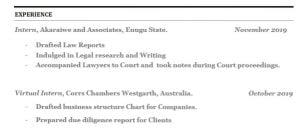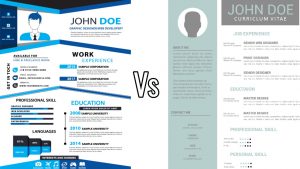How To Write a Curriculum Vitae (CV): A CV is a thorough document that highlights your scholarly and professional experience. It is abbreviation for the Latin term “curriculum vitae,” which means “life course.” Job experience, accomplishments and accolades, scholarships or fellowships you’ve received, courses, research projects, and articles of your work are often included in CVs. A CV is 2 or 3 pages long, but it’s not uncommon for it to be considerably longer for mid-level or advanced job seekers, since it acts as a comprehensive overview of one’s professional achievements.
You are basically selling your abilities, skills, and competences. Adhere to these steps to produce a fantastic CV and, perhaps, land the job you want.

Recommended: How to write a perfect affidavit
Brainstorming for Your CV
1. Understand the typical contents of a CV: Personal details, schooling and credentials, job experience, hobbies and accomplishments, talents, and recommendations are all included in conventional CVs. In addition, seasoned professionals will adapt your resume to the position you’re looking for. Use a design that is both current and professional. However, there is no standard structure for a CV; it is entirely up to you what information you provide.

2. Consider the position you’re applying for: Investigate the business. A excellent CV is personalized towards the job and organization for which you are seeking. What is the business’s mission statement? Is there a stated goal for them? What qualities do you believe they are searching for in a candidate? What qualifications does the job you’re looking for require? All of these considerations should be addressed while preparing your CV.
Also see: 9 Essentials of a valid contract
3. For further information about the CV, go to the company’s website: Check to see if they have any unique requirements for your CV. On the interface of the system, there may be particular instructions. This should always be double checked.
4. Create a list of all the jobs you’ve had: These might be occupations you’re doing now or ones you’ve done previously. Add t he dates on which you started and finished each job.
5. Generate a checklist of your hobbies and interests: You’ll stand out if you have distinctive interests or hobbies. Be careful of the assumptions that your interests may lead to. Instead of portraying yourself as a solitary, passive person, try to highlight interests that show you as a team player.
Businesses desire someone who can work effectively with others while still being able to lead if necessary. Hobbies and activities with a positive connotation: Becoming the captain of your soccer (or rugby) team, planning a charity fundraiser for an orphanage, and serving as treasurer of your institution’s student-run government are just a few examples.
Recommended: How to become an intelligent student at school
6. Generate a checklist of the abilities you have that are relevant: Computing capabilities (if you’re an expert at Blog? Excel? inDesign?, etc), dialects you speak, or particular items the organization is seeking for, including targeted talents, are all typical examples of these skills. As an example of focused talents, consider the following: If you’re looking to work as a reporter for a daily, mention that you’re familiar with AP style. Emphasize that you’ve worked with Scripting language if you’re looking for a programming job.
Steps for creating a Curriculum Vitae (CV)
Steps 1. Make a template for your CV: Will a line be used to separate each section? Is each part going to have its box? Will you make a list of everything you know? Experiment with several formats to discover which one appears the most official. Strive for little more than a regular sheet of paper’s front and back.

Steps 2. At the main page, provide your name, address, phone number, and email address: It’s crucial to keep your name bigger than the body of the text so that your evaluator knows who he or she is trying to read about. How you organize this data is entirely up to you.

Step 3. Create a profile for yourself: This is an elective section of the CV that allows your reviewer to have a better understanding of you as a person. This is where you promote your abilities, expertise, and personal characteristics. It must be unique and well-written. Positive phrases like “capable of adapting,” “assured,” and “determined” should be used.
Also see: How to improve your writing speed
Step 4. Make a section for your education and experience: This section can be placed at the front of your CV, or it can be placed after other sections. The sequence in which the sections are presented is entirely up to you. In reverse chronological order, list your schooling. If you went or are now attending university, start there and work your way backwards. List the name of the institution you attended, the dates you attended, your major and minor, and your GPA or A levels.

Step 5. Make a section about your professional experience: This is the area where you should mention all of your job experience that is relevant. List the company’s name, its location, the years you worked there, and what you did there. Working backwards, begin with your most recent employment. If you have a big list of work experience, simply provide the experiences that are relevant to the position.
Also see: Most profitable skills to learn in 2022
Step 6. Make a section for your accomplishments and talents: This part is where you highlight the accomplishments you’ve made in past employment as well as the skills you’ve gainedvia your experiences.
Furthermore, this is is where you should mention any published work, seminars you’ve given, workshops you’ve taught, and so on.
Step 7. Make a section for your hobbies: Any relevant interests that portray you in the best light should be listed. Pick a few passions from the list you made when conceptualizing your CV.
Step 8. Make a section for further information: Put this part in if your CV has an obvious gap or if you have any other information you’d want to offer. Leave your job to care for children, join the Peace Corps, and so on are examples of this type of information.
Recommended: Best budget laptops for programming students and experts
Step 9. Make a section for citations: These are people you’ve worked with previously, including instructors, prior employers, and others, who saw your work and can vouch for the compliments you’ve received. These references may be contacted by the firm you’re considering to learn further about your prior work.
Before putting someone as a reference, be sure they have the same phone number, are willing to provide you with a reference, and remember who you are. Make a list of their complete names as well as their contact details.
Recommended: Advantages and Disadvantages of a written constitution
Finalizing Your CV
1. Please double-check your spelling and punctuation: The simplest way to be dismissed is to have poor spelling. Future employers will be displeased if your CV is untidy or filled with mistakes. Double-checK that the company’s name, as well as any previous employers’ names, are spelt accurately.

2. Check for any sentences that might be expressed more succinctly: CVs that are succinct and well-written outperform CVs that are extensive and repetitious. Make sure you don’t repeat yourself—preferable it’s to describe a variety of your characteristics rather than the same few characteristics repetitively.
Also see: How to read for long hours Without Getting Tired or Sleepy
3. Examine your CV as if you were a representative of the organization to which you are appealing: What are your thoughts on the design and the information provided? Do you have a professional demeanor?
4. Have someone else go at your CV: What do they believe should be added or removed? If they were a corporation, would they hire you?
Recommended: Best and Most interesting books on Love and Relationships
Important tips note:
1. Your personal details should not include date of Birth, age, martial status, picture, gender and Local Government area.
2. Avoid errors in your CV, it must be perfectly edited and never use abbreviations.
3. Never use a CV for more than one Job application, always tailor your CV for the Particular Job you are applying for.
4. Include experience that are only relevant to the job you are applying for. For example, it is wrong to include your experience or accomplishment as a software developer when you are applying for a job placement in a Law firm. Never try to show off in your CV, simply include only the experience relevant to the Job you are applying for.
5. Keep your CV simple. A standard CV should not exceed 2 pages maximum. It is advisable to make your CV just a page.
6. Never lie in your CV.
7. Draft and send your CV in a Word document rather than PDF.
8. Define your goal early enough and start capturing opportunities and experiences relevant to that goal. This is in order to build your CV, because no matter how good you are drafting in a CV, you can’t draft CV where you have little or no experience to include in the CV.
Recommended: How to start a conversation with someone for the first time
Conclusion
Although there is no standard structure for a CV, you should select one that appears professional and well-organized. If you’re unsure where to begin, browse online for CV templates or utilize a built-in template from your word processing application. The format of your CV may be required by the job or program you’re applying for.
If you’re a student, you probably don’t have much work experience to include on your CV. Include any employment experience you’ve had, including part-time work-study positions, and emphasis on the skills you learned while performing those tasks. You might also highlight your academic credentials as well as any relevant abilities you’ve acquired via your studies. Extracurricular activities, such as debate club or working on the student newspaper, might help you stand out to companies.

Edeh Samuel Chukwuemeka, ACMC, is a lawyer and a certified mediator/conciliator in Nigeria. He is also a developer with knowledge in various programming languages. Samuel is determined to leverage his skills in technology, SEO, and legal practice to revolutionize the legal profession worldwide by creating web and mobile applications that simplify legal research. Sam is also passionate about educating and providing valuable information to people.
hello everyone